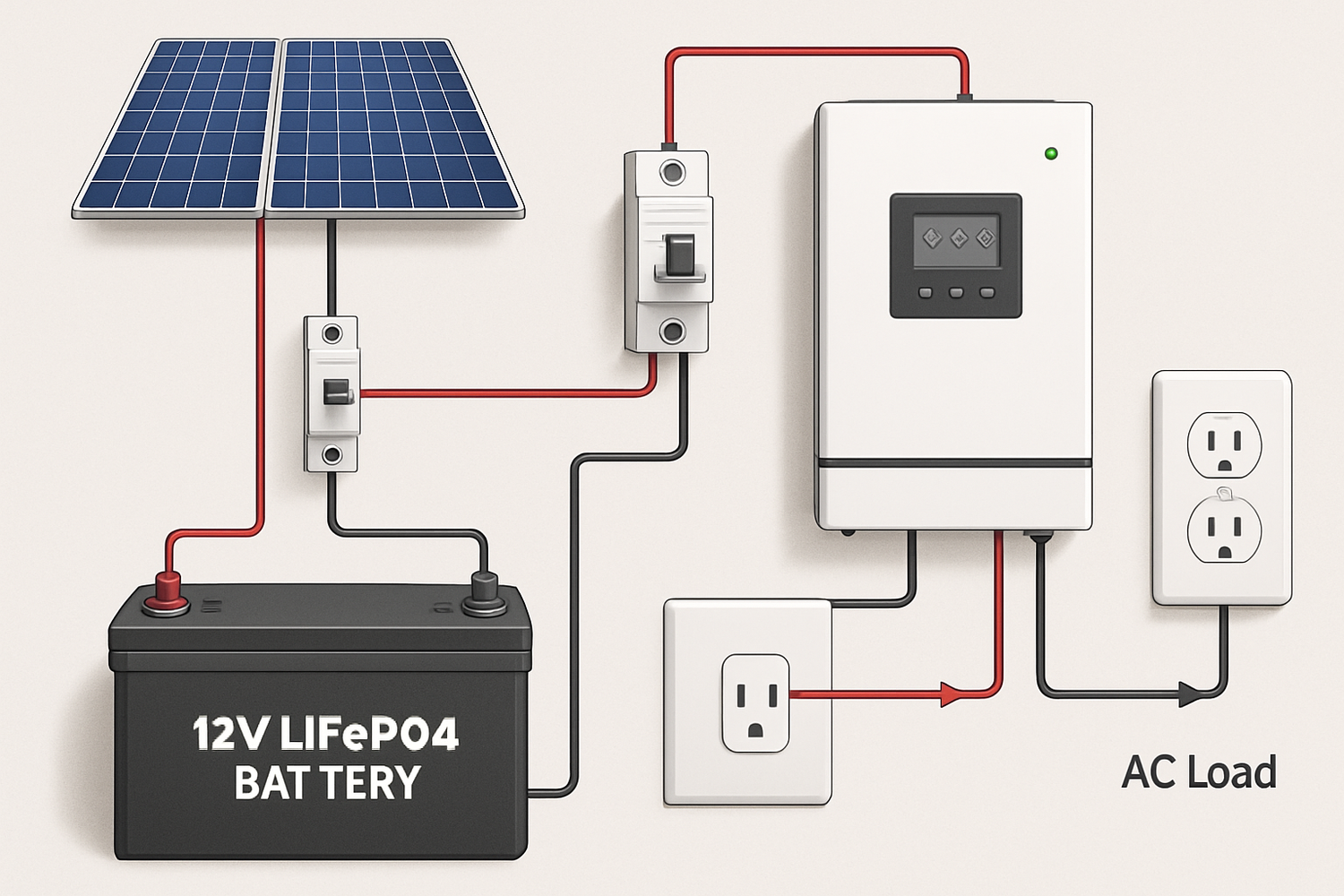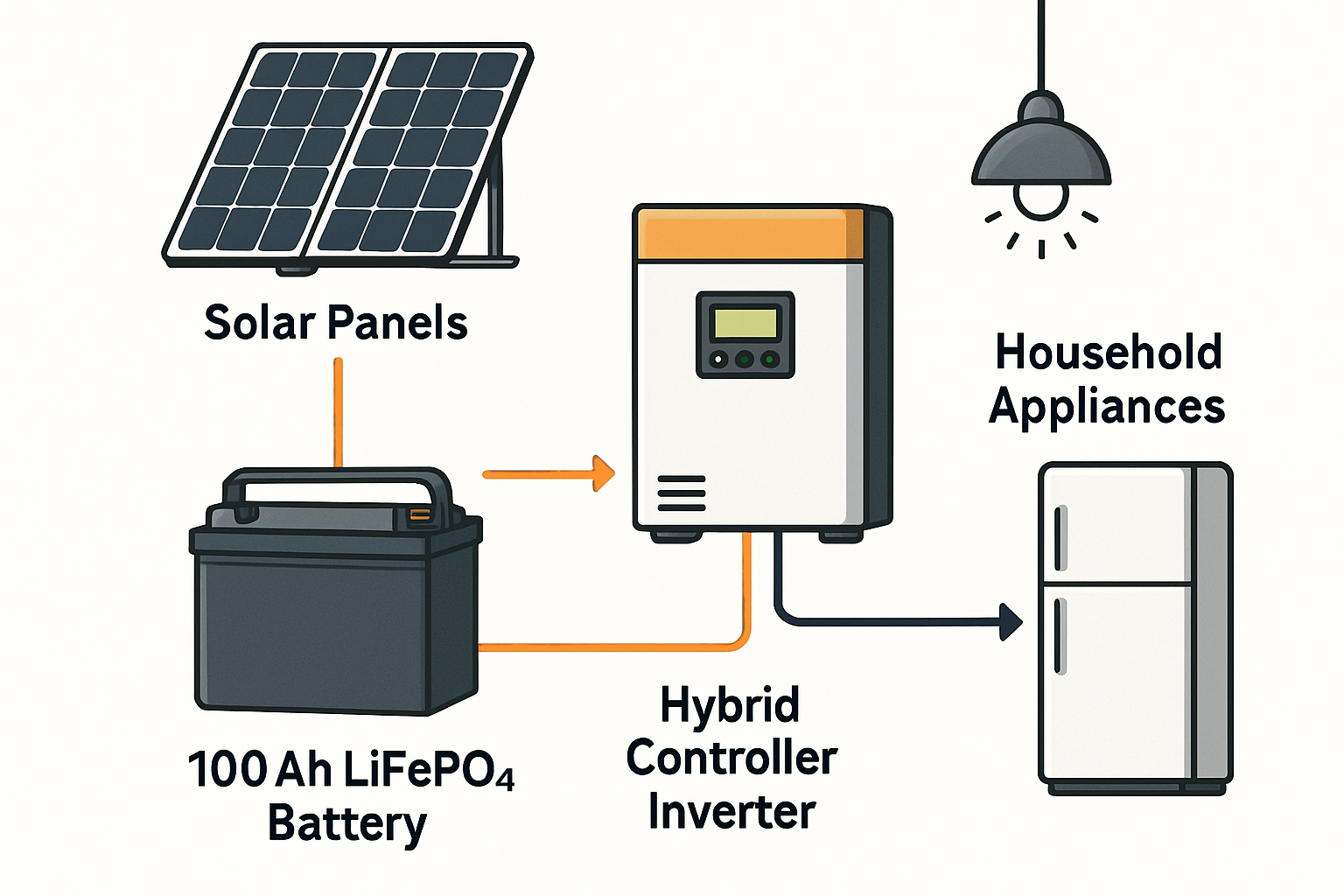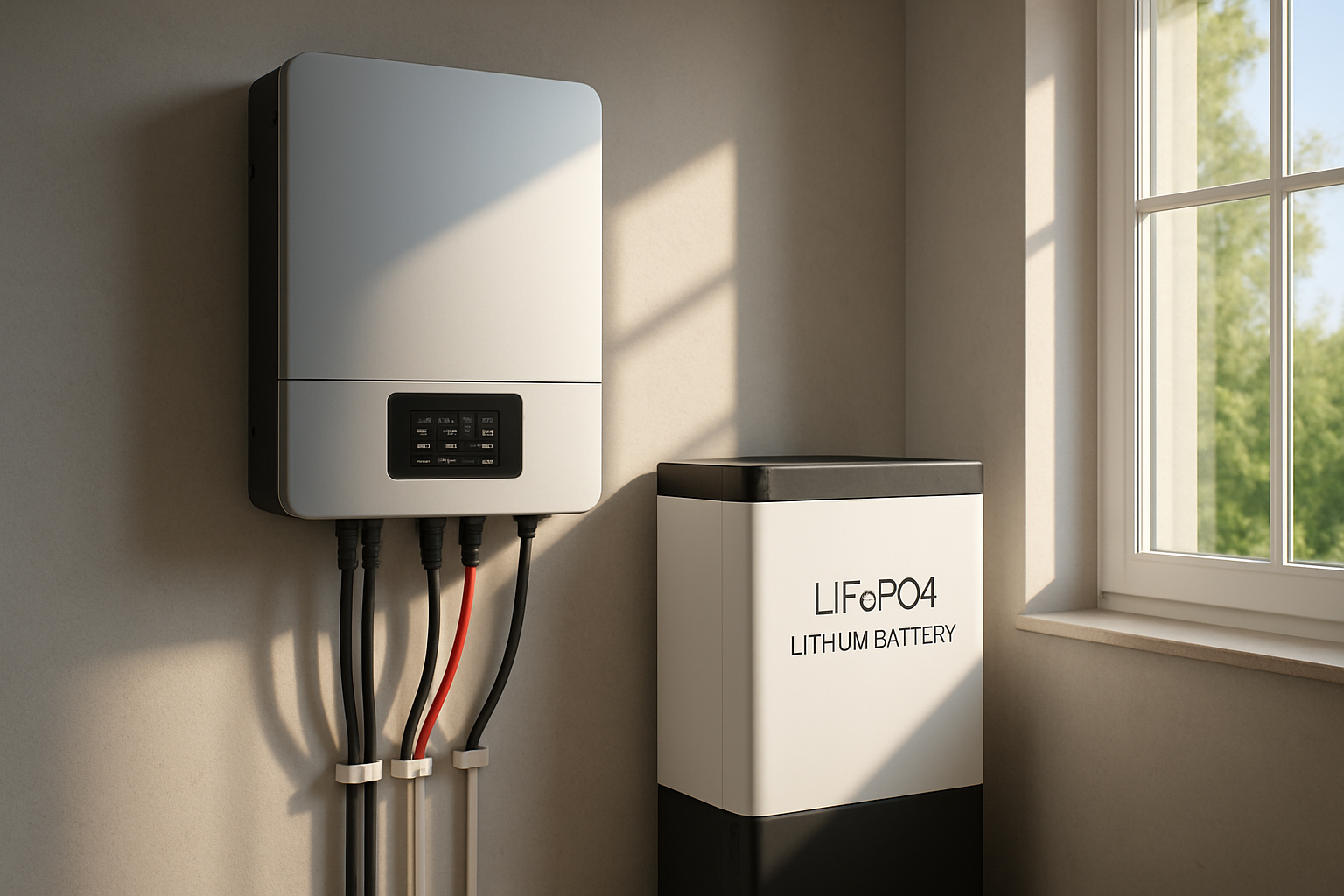Creating a dependable solar energy system hinges on the synergy between its core components. The hybrid controller inverter and the 12V LiFePO4 battery are two such critical elements. Pairing them correctly is fundamental for achieving optimal performance, ensuring operational safety, and maximizing the lifespan of your investment. An improper match can lead to inefficiency, reduced battery life, or even system failure. This text provides the essential knowledge for a successful hybrid inverter and 12V lithium battery combination, from verifying compatibility to fine-tuning settings for long-term reliability.
Understanding the Core Components
A successful energy system is built on a solid understanding of its parts. The hybrid inverter and the LiFePO4 battery each play a distinct, vital role. Recognizing their individual strengths is the first step toward creating a powerful and cohesive unit.
What Makes a Hybrid Inverter a Smart Choice?
A hybrid inverter is the intelligent hub of a modern solar power system. It masterfully combines the functions of a standard solar inverter and a battery inverter into a single, efficient unit. This integration allows it to manage power flow from multiple sources—solar panels, the utility grid, and a battery bank—seamlessly. According to the International Energy Agency's Next Generation Wind and Solar Power report, advanced inverters are crucial for grid stability, and a hybrid inverter's ability to manage stored energy makes it a key player in creating resilient, distributed energy resources. This capability ensures you have a reliable power supply, day or night, on-grid or off-grid.
The Advantages of a 12V LiFePO4 Battery
The 12V LiFePO4 (Lithium Iron Phosphate) battery has become a preferred choice for energy storage, and for good reason. Its chemistry offers superior thermal stability and safety compared to other lithium-ion variants. These batteries boast an exceptionally long cycle life, often capable of thousands of charge-discharge cycles while retaining a high percentage of their original capacity. They can also be discharged more deeply without sustaining damage, giving you more usable energy from a smaller, lighter package. This combination of safety, longevity, and high performance makes the lithium iron phosphate battery an ideal foundation for robust energy storage solutions.
Key Compatibility Factors for a Successful Pairing
Simply connecting a hybrid inverter to a 12V LiFePO4 battery is not enough. True compatibility requires a careful check of technical specifications to ensure the two components can work together safely and efficiently. Overlooking these details can compromise your entire system.
Voltage and Current Specifications
The most fundamental check is voltage compatibility. The inverter's DC input range must accommodate the nominal 12V of the LiFePO4 battery. Equally important is the current rating. The battery's Battery Management System (BMS) dictates the maximum continuous discharge current. This must be sufficient to meet the inverter's power demands. For example, a 1500W inverter running at full capacity on a 12V system will draw approximately 125A (1500W / 12V = 125A). Your battery's BMS must be rated to handle this current continuously.
| Inverter Power (Watts) | Estimated Current Draw at 12V (Amps) | Recommended Minimum Battery Discharge Rating |
|---|---|---|
| 1000W | ~83A | 100A Continuous |
| 1500W | ~125A | 150A Continuous |
| 2000W | ~167A | 200A Continuous |
Communication and Battery Management System (BMS)
The BMS is the brain of the LiFePO4 battery, protecting it from overcharging, over-discharging, and extreme temperatures. Advanced hybrid systems use 'closed-loop' communication, where the inverter and BMS talk directly to each other using protocols like CANbus or RS485. This allows the inverter to receive real-time data on the battery's state of charge (SoC), voltage, and temperature, enabling much smarter charging and discharging decisions. If direct communication isn't supported ('open-loop'), the inverter relies solely on its own voltage readings, which is less precise but still functional if configured correctly.
Charging Profile Configuration
LiFePO4 batteries require specific charging parameters that differ significantly from traditional lead-acid batteries. Using the wrong charging profile can severely damage the battery and shorten its life. A compatible hybrid inverter must allow you to customize the charging settings. You need to set specific voltages for the Bulk, Absorption, and Float charging stages to match the battery manufacturer's recommendations. Never use a default lead-acid or AGM setting for a LiFePO4 battery.
A Step-by-Step Connection Process
With compatibility confirmed, the next phase is the physical connection and software configuration. A methodical and safety-conscious approach is essential to prevent equipment damage and ensure personal safety. Follow these steps carefully to establish a secure and functional link.
Safety First: Pre-Connection Checklist
Before touching any wires, prioritize safety. Ensure the hybrid inverter, solar panels, and any other power sources are completely turned off and disconnected. Wear appropriate personal protective equipment (PPE), including safety glasses and insulated gloves. Use properly insulated tools to prevent accidental short circuits. Finally, verify you have the correct gauge of cables and appropriately rated fuses or circuit breakers for the expected current.
Making the Physical Connections
The primary connection involves linking the battery's terminals to the inverter's DC input terminals. Adhering to correct polarity is absolutely critical: connect the positive (+) terminal of the battery to the positive (+) terminal of the inverter, and the negative (-) terminal to the negative (-) terminal. Reversing these connections can cause severe damage to the inverter, the battery, or both. Use cables of the appropriate thickness (gauge) to handle the high current without overheating. Ensure all connections are tight and secure to minimize electrical resistance.
Configuring the Inverter Settings
Once the physical connection is secure, power on the inverter and navigate to its system setup or battery configuration menu. This is a crucial step. Select the 'Lithium' or 'LiFePO4' battery type if available. If not, use a 'User-Defined' or 'Custom' setting to manually input the correct charging parameters. As a general starting point for a 12V LiFePO4 battery, typical settings are:
- Bulk/Absorption Voltage: 14.2V - 14.6V
- Float Voltage: 13.6V - 13.8V
- Low Voltage Cutoff: 11.6V - 12.0V
Always consult your battery's specific datasheet for the most accurate values. For a deeper look into performance metrics and how to refine these settings, the Ultimate Reference for Solar Storage Performance offers valuable data and insights for optimizing your system.
Optimizing Performance and Extending System Lifespan
A properly connected system is just the beginning. To get the most out of your investment, ongoing optimization and monitoring are key. Small adjustments to how you use your system can lead to significant gains in performance and longevity, ensuring your energy independence for years to come.
Setting the Right Depth of Discharge (DoD)
While LiFePO4 batteries can handle deep discharges, you can significantly extend their cycle life by not draining them completely on a regular basis. Setting a conservative Depth of Discharge (DoD) limit in your inverter—for example, 80%—means you will only use 80% of the battery's capacity before it recharges. This practice puts less stress on the battery, leading to a much longer service life without a noticeable impact on daily performance.
Temperature Considerations
LiFePO4 batteries perform best within a moderate temperature range, typically between 0°C and 45°C (32°F and 113°F). The BMS will protect the battery by preventing charging in freezing temperatures. Ensure your battery bank is installed in a location with adequate ventilation to prevent overheating during heavy use. Avoid placing it in direct sunlight or in uninsulated spaces that experience extreme temperature swings.
Regular System Monitoring
Modern hybrid inverters offer sophisticated monitoring capabilities, often through a display panel or a smartphone app. Make it a habit to regularly check your system's key metrics. Monitor the battery's state of charge, voltage levels, and the amount of energy being produced and consumed. As highlighted in reports from the International Renewable Energy Agency (Grid Codes for Renewable Powered Systems), effective monitoring is key to maintaining system stability and reliability. This practice helps you understand your energy usage patterns and allows you to spot any potential issues before they become serious problems.
Final Thoughts on System Synergy
Achieving a successful hybrid controller inverter combination with a 12V LiFePO4 battery is about more than just connecting wires. It requires a thoughtful approach centered on compatibility, precise configuration, and diligent monitoring. By ensuring the voltage and current specifications align, setting the correct charging profiles, and respecting the battery's operational limits, you create a powerful synergy. This well-matched pairing forms the backbone of a resilient, efficient, and long-lasting energy storage solution, empowering you to achieve greater energy independence.
Frequently Asked Questions
Can I use any hybrid inverter with a 12V LiFePO4 battery?
No. It is crucial to select a hybrid inverter that explicitly supports LiFePO4 battery chemistry or offers fully customizable charging parameter settings. Using an inverter with fixed charging profiles for lead-acid batteries can damage your LiFePO4 battery and create safety risks.
What size inverter do I need for a 100Ah 12V LiFePO4 battery?
The inverter size is determined by the power of the appliances you want to run, not the battery's capacity. A 12V 100Ah LiFePO4 battery with a standard 100A continuous discharge BMS can typically support an inverter up to about 1200W (12V x 100A = 1200W). Always check the battery's specifications for its maximum continuous discharge rate before selecting an inverter.
Do I need a separate solar charge controller with a hybrid inverter?
No, one of the primary advantages of a hybrid inverter is that it includes an integrated solar charge controller, usually a highly efficient MPPT (Maximum Power Point Tracking) type. This simplifies system design, reduces the number of components, and ensures efficient power management from your solar panels to your batteries and loads.





Leave a comment
All comments are moderated before being published.
This site is protected by hCaptcha and the hCaptcha Privacy Policy and Terms of Service apply.